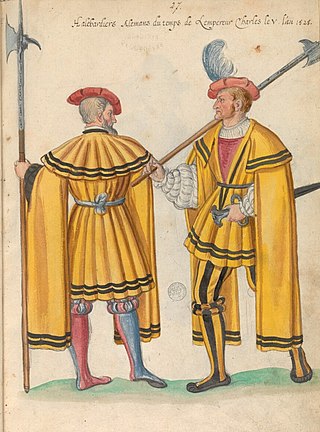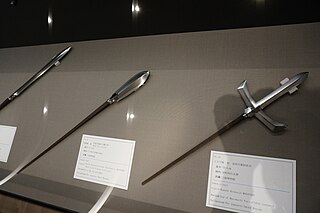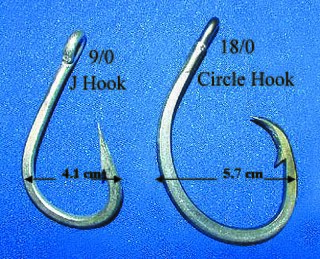
A hammer is a tool, most often a hand tool, consisting of a weighted "head" fixed to a long handle that is swung to deliver an impact to a small area of an object. This can be, for example, to drive nails into wood, to shape metal, or to crush rock. Hammers are used for a wide range of driving, shaping, breaking and non-destructive striking applications. Traditional disciplines include carpentry, blacksmithing, warfare, and percussive musicianship.

A knife is a tool or weapon with a cutting edge or blade, usually attached to a handle or hilt. One of the earliest tools used by humanity, knives appeared at least 2.5 million years ago, as evidenced by the Oldowan tools. Originally made of wood, bone, and stone, over the centuries, in step with improvements in both metallurgy and manufacturing, knife blades have been made from copper, bronze, iron, steel, ceramic, and titanium. Most modern knives have either fixed or folding blades; blade patterns and styles vary by maker and country of origin.

A polearm or pole weapon is a close combat weapon in which the main fighting part of the weapon is fitted to the end of a long shaft, typically of wood, extending the user's effective range and striking power. Polearms are predominantly melee weapons, with a subclass of spear-like designs fit for thrusting and/or throwing. Because many polearms were adapted from agricultural implements or other fairly abundant tools, and contained relatively little metal, they were cheap to make and readily available. When belligerents in warfare had a poorer class who could not pay for dedicated military weapons, they would often appropriate tools as cheap weapons. The cost of training was comparatively low, since these conscripted farmers had spent most of their lives using these "weapons" in the fields. This made polearms the favoured weapon of peasant levies and peasant rebellions the world over.

A halberd is a two-handed polearm that came to prominent use from the 13th to 16th centuries. The halberd consists of an axe blade topped with a spike mounted on a long shaft. It can have a hook or thorn on the back side of the axe blade for grappling mounted combatants and protecting allied soldiers, typically musketeers. The halberd was usually 1.5 to 1.8 metres long.

A saw is a tool consisting of a tough blade, wire, or chain with a hard toothed edge used to cut through material. Various terms are used to describe toothed and abrasive saws.

Yari (槍) is the term for a traditionally-made Japanese blade in the form of a spear, or more specifically, the straight-headed spear. The martial art of wielding the yari is called sōjutsu.

The Unix philosophy, originated by Ken Thompson, is a set of cultural norms and philosophical approaches to minimalist, modular software development. It is based on the experience of leading developers of the Unix operating system. Early Unix developers were important in bringing the concepts of modularity and reusability into software engineering practice, spawning a "software tools" movement. Over time, the leading developers of Unix established a set of cultural norms for developing software; these norms became as important and influential as the technology of Unix itself, and have been termed the "Unix philosophy."

Glossary of climbing terms relates to rock climbing, mountaineering, and to ice climbing.

Esox is a genus of freshwater fish commonly known as pike or pickerel. It is the type genus of the family Esocidae. The type species of the genus is Esox lucius, the northern pike.

A mahout is an elephant rider, trainer, or keeper. Mahouts were used since antiquity for both civilian and military use. Traditionally, mahouts came from ethnic groups with generations of elephant keeping experience, with a mahout retaining his elephant throughout its working life or service years.
This is a glossary of firefighting equipment.

A billhook or bill hook is a versatile cutting tool used widely in agriculture and forestry for cutting woody material such as shrubs, small trees and branches. It is distinct from the sickle. It was commonly used in Europe with an important variety of traditional local patterns. Elsewhere, it was also developed locally such as in the Indian subcontinent, or introduced regionally as in the Americas, South Africa, and Oceania by European settlers.

A cant hook or pike or a hooked pike is a traditional logging tool consisting of a wooden lever handle with a movable metal hook called a dog at one end, used for handling and turning logs and cants, especially in sawmills. A cant dog has a blunt end, or possibly small teeth for friction.

A fire iron is any metal instrument for tending a fire.

A circle hook is a type of fish hook which is sharply curved back in a circular shape. It has become widely used among anglers in recent years because the hook generally catches more fish and is rarely swallowed. Since the circle hook catches the fish on the lips at the corner of its mouth, it usually decreases the mortality rates of released fish as compared to J-hook which are often swallowed by the fish, causing damage to the gills or vital organs. The circle hook's shape allows it to only hook onto an exposed surface, which in the case of a fish means the corner of its mouth. The fish takes the baited hook and swallows it, and as the hook is reeled in, it is safely pulled out of the fish until it reaches the mouth. At this point it will catch the corner of the mouth, resulting in fewer gut-hooked fish.

An axe is an implement that has been used for millennia to shape, split, and cut wood, to harvest timber, as a weapon, and as a ceremonial or heraldic symbol. The axe has many forms and specialised uses but generally consists of an axe head with a handle, also called a haft or a helve.
Builders' hardware or just builders hardware is a group of metal hardware specifically used for protection, decoration, and convenience in buildings. Building products do not make any part of a building, rather they support them and make them work. It usually supports fixtures like windows, doors, and cabinets. Common examples include door handles, door hinges, deadbolts, latches, numerals, letter plates, switch plates, and door knockers.

An ironworker is a tradesman who works in the iron-working industry. Ironworkers assemble the structural framework in accordance with engineered drawings and install the metal support pieces for new buildings. They also repair and renovate old structures using reinforced concrete and steel. Ironworkers may work on factories, steel mills, and utility plants.

A boat hook is part of boating equipment. Its most common use is as a docking and undocking aid. It may be similar to a pike pole, however it commonly has a blunt tip, for pushing during undocking, with a hook for docking. In addition, it may have a line attached to the other end, which may have a ring for this purpose.



















